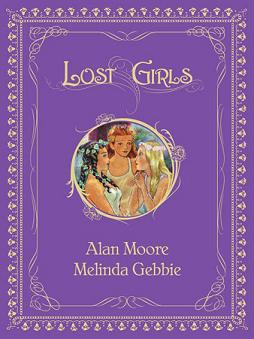Comics /
Comic Reviews /
More Comics
Alan Moore's Lost Girls
By Geoff Hoppe
March 12, 2008 - 20:36
In Lost Girls, author Alan Moore’s three-volume erotic graphic novel, three heroines from nineteenth and early 20th century fiction meet at an Austrian hotel on the eve of World War I. These three are Dorothy Gale from The Wizard of Oz, Alice Fairchilde from Alice in Wonderland, and Wendy Potter (nee Darling) from Peter Pan. Only, they’re older now: Dorothy is in her late teens or early twenties, Wendy is a middle-aged housewife, and Alice is pushing sixty, if not more. The lustful Alice inspires Dorothy and Wendy to sexually experiment with her, A LOT, and the three women reveal that their magical childhood adventures were actually metaphors for sexual experiences they had with teachers, farmhands, mechanics, homeless children, parents, siblings, classmates, bankers, hookers, President Theodore Roosevelt and his Rough Riders, the United States Navy, and the 1977 Philadelphia Flyers.
THE OBLIGATORY WARNING: ridiculously graphic depictions of every kind of sex imaginable. Rape. Incest. Bestiality. A sole disembowelment.
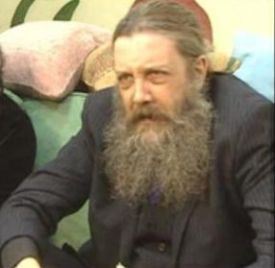 |
| Author Alan Moore. Notice how you never see him and Santa together... |
I’d call Lost Girls an ode to liberal platitudes regarding sexual mores, but the ideals it celebrates are so dead, it’s really more of a paean. The bluntly hammered lessons of Lost Girls-- that free love liberates the body and soul, that repression is the ultimate evil, and that “war destroys all the art and architecture, the fields of flowers and young people’s dreams…all the imagination”--went stale sometime in the mid-1970s. Leftists today pay these ideals lip service, of course, much the same way most modern catholics acknowledge transubstantiation, but don’t believe it. But Moore misses the boat, even as his heroines swim out to meet troop ships. A book arguing against repression in the 2000’s is about as relevant as a book arguing against the gold standard. Sexual behavior in the western world isn’t a discussion anymore. It’s a set of seemingly casual assumptions so overbearing they’d make an Ibsen play look positively freewheeling.
There is one thing Alan Moore gets right, though. He’s had historic foresight in jam-packing one volume with all his personal ideas regarding sex. You see, back in antiquity/the middle ages/the Renaissance, authors and poets selfishly waited until they died, then expected other people to provide an apotheosis for them. The shame! The temerity! Blessed be, then, that Alan Moore has thought to inform his public why he’s more sagacious than they with properly pedantic polemics. Now I don’t have to wait for him to die before I understand the myriad ways his vast storehouse of wisdom enriches my feeble mind.
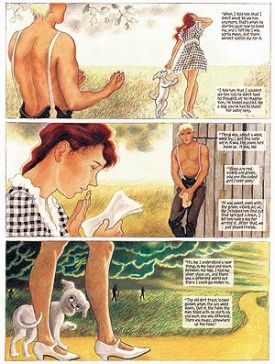 |
| Why does Toto look like an idiot? |
Most of Lost Girls takes place at the Himmelgarten, an Austrian hotel staffed entirely by prostitutes and owned by a pedophilic fat guy. Said pedophilic fat guy has left books of classic erotic literature around the hotel, and these books play an active role in both the story and the heroines’ constant nooky making. The presence of crappy literary porn within crappy literary porn makes Lost Girls a story-within-a-story, which should amuse most lower life forms like college philosophy majors, Stanley Kubrick fans, and anybody who thought Waking Life was more than a glorified screensaver. There’s more fictional character sex in this book than in all the fevered imaginations of an entire Harry Potter fan-fiction internet forum. One could argue that Lost Girls itself is simply bad relationship fan-fiction (ship-fic, for those in the know) for nerdy people who know too much. Only, and I never thought I’d say this, there’s plenty of other ship-fic I’d rather read, up to but not including anything featuring Harry Potter, Voldemort and Cedric Diggory and perhaps bearing the title “Boys of Hogwarts Vol. 3: Expecto my whorecrux, stud.”
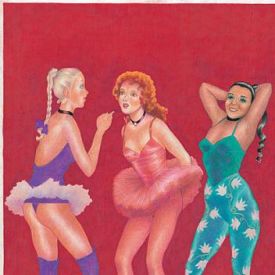 |
| Nothing says "sexual equality" like a pretty pretty princess dress-up party. |
Sexagenarian Alice Fairchilde leads the charge into coitus country, seducing a willing Dorothy, and then a curious Wendy. As Dorothy and Wendy fall victim to the wiles Alice learned from her “Sex for Seniors” VHS collection, they become more open about their youthful erotic escapades. Apparently, all the fanciful adventures the girls had are simply metaphors for sex. Dorothy didn’t go to Oz, but she did seduce three farmhands who become the Scarecrow, the Tin Man, and the Cowardly Lion. Wendy never flew to Neverland-- but she, and her brothers, did have sex with a wild, red-haired adolescent in a London park. Alice didn’t meet the Queen of Hearts-- but she did have a teacher who seduced her, and taught her all about how to please a woman. There’s more detail to these metaphors than listed here, and rest assured Moore is unmercifully thorough in the way he adapts beloved childhood stories into erotic romps. Though, at least he avoids making dirty metaphor out of Dorothy’s visit to Munchkinland (we represent the lollipop guild WITH OUR PANTS DOWN, YOU NAUGHTY MINX). Moore clearly wants these extended metaphors to be a glittering synthesis of juvenile storytelling and erotic fantasy, a justification of his argument that sexual experimentation is empowering and enlightening. In reality, making highbrow smut out of children’s literature is just enormously depressing. It’s as if Christopher Robin suddenly realized the Hundred-Acre Wood were just his backyard, and calmly put away those juvenile stuffed animals so he could tend to more important affairs.
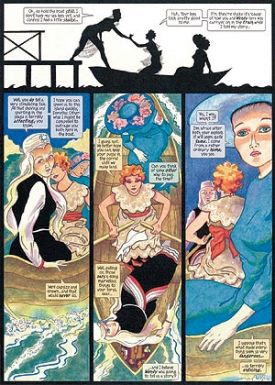 |
| Dorothy, Alice and Wendy on their way to perk up the crew of the USS Nimitz. |
Despite the massive amounts of action (pun intended), the characters are strikingly unimpressive. The heroines’ experiences are so clearly calculated to prove a point that any sympathy is overpowered by the knowledge that these characters are pawns in Moore’s gooey, erotic design. Nor are their voices compelling. Alice Fairchilde is the cool, collected, brainy one who pulls the strings. In other words, she’s a clone of Watchmen’s Ozymandias or League of Extraordinary Gentlemen’s Mina Harker. Wendy Potter is so cliché she’s barely worth mentioning. Her proto-suburban repression and subsequent sexual liberation are hardly felt; they’re a fleshy canvas for Moore to squirt bodily fluids upon like a deranged Jackson Pollack. Worst of all, Kansan Dorothy Gale is hopelessly provincial, and speaks with a twang crammed full of “aw shucks” and “t’weren’t nothing’”s. Good to know all Americans are idiots. Being American, I get so confused about that fact, and I need someone to hold my hand and remind me.
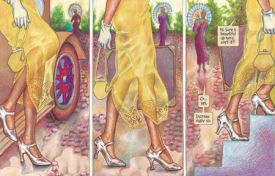 |
| Cue the muted trombones. |
A secondary tragedy in all this is the blatant misuse of the authors’ talent. Moore weaves the fictional events of his story into the real events of history so well, one almost believes his lurid, pedantic mess. His use of history is meticulously well inserted (ok, that time, no pun intended). The references to early 20th century culture and history are so well incorporated, they become more than mere references. They’re an organic part of the vibrant fabric of the text.
Alan Moore’s ability to write exceptionally well is beyond argument. You can hate every word he writes…but just try and stop reading. It’s not easy. Yet, he’s repeatedly misapplied himself, attacking everything from heroism (Watchmen), to Britain itself (the muted postcolonial rantings of League of Extraordinary Gentlemen), and now chastity. Alan Moore’s career is a walking compression of Yeats’ caveat from “The Second Coming:” the best writer of his generation, full of both conviction and passionate intensity, becomes, by his own ignorance, the worst thing to happen to comics since Frederic Wertham.
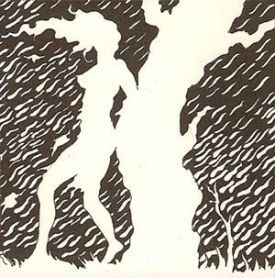 |
| It's a lousy night in a lousy part of Austria...crap, wrong comic. |
Moore’s use of existing art and literature is less successful than his use of history. When Lost Girls quotes from the erotic fin de siecle books littered about the Himmelgarten, it does so in the most direct fashion possible. In many chapters, half the page is taken up with quotes and images from The Portrait of Dorian Grey or Venus and Tannhauser, embedded in the story like a saint’s bone in a reliquary. While I’m always thrilled to see contemporary fiction acknowledge and incorporate the history that informs it, Moore’s particular use of books and works of art comes across as fetish. There’s none of the masterful aplomb that characterized Moore’s use of “secondary sources” in Watchmen. Here, his incorporation of everything from the music of Igor Stravinsky to the incestuous vignettes of Pierre Louys stands out as set pieces rather than organic parts of the book. They’re so front-and-center, in fact, that the reader almost expects the end of each chapter to have study questions affixed to it, like in a bad history textbook. END OF CHAPTER REVIEW 1) How did the illustrious author use the riot at the premiere of “Rite of Spring” to underscore the way Alice Fairchilde was banging Wendy Darling? The references are more oblique than the “SEE ISH 431!--ED.” that pepper the mainstream comics of the 1960s and 70s.
Melinda Gebbie, likewise, proves herself beyond capable. Looking at her ethereal images, one (desperately) hopes she’ll someday adapt the works of Samuel Taylor Coleridge. The colors of Lost Girls, ridiculously lush and beautiful, are perhaps the book’s best feature. They, too, conjure up the art of the early 20th century, and every few pages, the reader feels they’ve stumbled into Matisse’s Luxe, Calme, et Volupte, or an Andre Derain landscape. This is all to say she knows her sh*t.
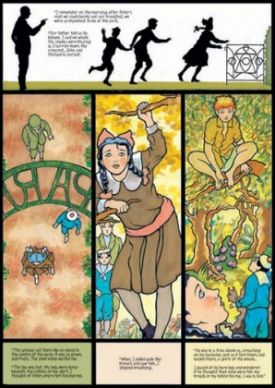 |
| Wendy meets Peter. This is the last time you'll see her clothed for awhile. |
That said, Moore’s effort can’t legitimately be called creative. The sex in Lost Girls is so self-serving of Moore’s goals, it’s almost masturbation. Perhaps the reason behind Moore’s obsessive focus on creativity, literary issues, and even other books is because he knows, somewhere in that labyrinthine psyche of his, that the things he depicts aren’t beautiful, creative expressions of desire. They’re as barren and life-denying as Narcissus’ death by drowning. Lost Girls is a swirling mess of contradictions. It claims to be dedicated to creativity and free expression, but the didactic plot and highly structured chapters make it more repressed than the Baltimore Catechism. The tension between Moore’s preaching and the characters’ supposed innocence tears Lost Girls in half like a phone book. I could go on about the colossal irony of a book about sex engendering nothing sincerely creative, but, in Lost Girls fashion, I’ll let another text (Alexander Pope, if you’re wondering) say it for me--
See sin in state, majestically drunk,
Proud as a peeress, prouder as a Punk;
Chaste to her husband, frank to all beside,
A teeming mistress, but a barren bride.
Worth the money? Since Lost Girls costs $75, the answer would be doubtful even if I liked it. Besides, 75 bucks will buy a lot of Hagrid-on-Dolores Umbridge ship-fic…
Last Updated: January 17, 2025 - 08:20
